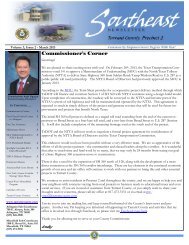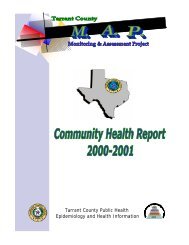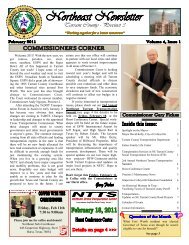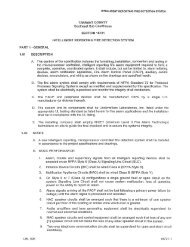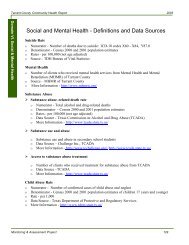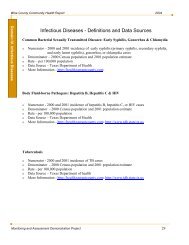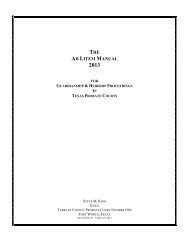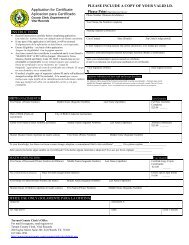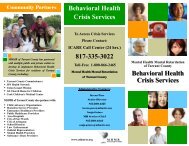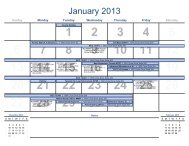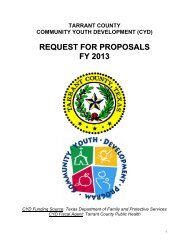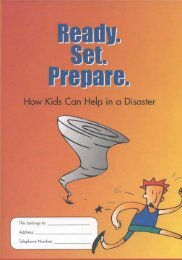MAPP Handbook - The National Association of County and City ...
MAPP Handbook - The National Association of County and City ...
MAPP Handbook - The National Association of County and City ...
You also want an ePaper? Increase the reach of your titles
YUMPU automatically turns print PDFs into web optimized ePapers that Google loves.
one entity because <strong>of</strong> the geographic <strong>and</strong> ethnic diversity (e.g., people from many<br />
regions <strong>of</strong> Latin America).<br />
Due to air quality concerns, a group <strong>of</strong> residents in North Central had already come<br />
together to actively address the health <strong>of</strong> their community. This group accepted an<br />
invitation to be part <strong>of</strong> the <strong>MAPP</strong> initiative. <strong>The</strong> <strong>MAPP</strong> committee helped facilitate<br />
their proceedings <strong>and</strong> provided the necessary statistical information for them to<br />
underst<strong>and</strong> some <strong>of</strong> the health conditions facing their residents <strong>and</strong> themselves. <strong>The</strong><br />
<strong>MAPP</strong> committee’s first proposal was that their focus be broadened from air quality to<br />
quality <strong>of</strong> life. <strong>MAPP</strong> partners would assist them in addressing issues that arose from<br />
the various assessments. <strong>The</strong> <strong>MAPP</strong> Quality <strong>of</strong> Life tool was modified to reflect the<br />
culture <strong>of</strong> the neighborhood <strong>and</strong> to include environmental factors- there were<br />
questions about air, water, l<strong>and</strong>, <strong>and</strong> infrastructure. Residents were recruited to<br />
complete the survey with a student from a local university. <strong>The</strong> neighborhood was<br />
divided into 10 areas, <strong>and</strong> each area was sampled. Health issues identified matched<br />
statistical data: chronic diseases, smoking, <strong>and</strong> lack <strong>of</strong> exercise. This neighborhood<br />
moved to an action plan very quickly <strong>and</strong> wrote for two grants to address heart health<br />
<strong>and</strong> exercise. Both proposals were funded.<br />
Vignette: Columbus, OH<br />
Residents <strong>of</strong> North Central participated in a heart health project conducted under the<br />
direction <strong>of</strong> the American Heart <strong>Association</strong> <strong>and</strong> in an exercise program held at<br />
elementary schools <strong>and</strong> recreation centers. <strong>The</strong>se programs reached over 300<br />
residents. Most participants succeeded in lowering their cholesterol, increasing<br />
exercise times, <strong>and</strong> eating healthier. Some <strong>of</strong> the programs have proved sustainable<br />
because aerobics instructors were trained from the neighborhood <strong>and</strong> they continue<br />
to provide this opportunity after grant completion.<br />
<strong>The</strong> Local Public Health System Assessment<br />
<strong>The</strong> <strong>MAPP</strong> committee decided to approach this phase as a community-wide<br />
assessment. <strong>The</strong> committee was not able to bring all stakeholders together at one<br />
time to review each st<strong>and</strong>ard <strong>and</strong> indicators. With the involvement <strong>of</strong> a graduate<br />
student from the Ohio State School <strong>of</strong> Public Health, the <strong>MAPP</strong> committee<br />
interviewed 41 stakeholders representing public health pr<strong>of</strong>essionals, immigrant<br />
community members, business persons, health care providers, educators, insurers,<br />
government leaders, foundations, advocacy groups, faith community leaders,<br />
evaluators, community based organizations, <strong>and</strong> agencies. <strong>The</strong> interviews were<br />
designed around the model st<strong>and</strong>ards for each indicator. For analysis the<br />
interviewees were divided into three groups: providers, funders, <strong>and</strong> general public.<br />
Next, the 10 Essential Public Health Services were categorized as Assessment<br />
(monitor, diagnose),Assurance (enforce, link, competent workforce, <strong>and</strong> evaluate), or<br />
Policy Development (mobilize, inform, develop policy).<br />
Using these broad categories the committee concluded that as a system, Columbus<br />
was doing fairly well in the areas related to Assessment; achieving 60 percent to 80<br />
percent <strong>of</strong> what is needed <strong>and</strong> public health is contributing 63 percent to 75 percent <strong>of</strong><br />
the investment. <strong>The</strong> system was not doing as well in the area <strong>of</strong> Assurance. Sixty<br />
percent <strong>of</strong> this function was being accomplished <strong>and</strong> public health contributes 50<br />
percent <strong>of</strong> the effort. In Policy Development Columbus was at 59 percent <strong>of</strong> where it<br />
COLUMBUS,OH<br />
129



